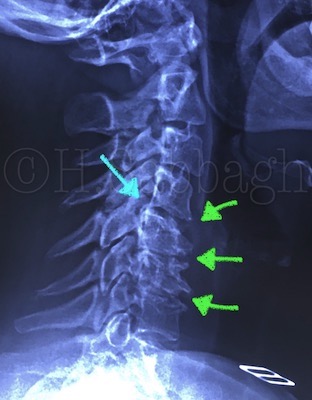Discussion
Bio-mechanical diagnosis is an integral component of Chiropractic Clinical Diagnosis, which must be accurately reached prior to initiating any treatment protocol.
The spinal column is a dynamic structure which responds differently under sequential load factors, affected by a number of bio-mechanical variations, one of which is inter-segmental hypo-mobility . As such, it should always be considered in the overall context.
It is important to have a clear understanding of the etiology of the inter-segmental dysfunctions (ISD) affecting the spinal column, and hypo-mobility as only a component.
In this particular case, a number of flaws in the clinical decision-making process can be pointed out which has lead to poor clinical outcomes.
Even so, the treating clinician had ordered a two-view plain film study of the cervical spine in the initial phase (AP, Lateral, in addition to APOM), inadequate attention was paid to the extent of the degenerative changes, and possible unstable segments.
The initial study should have been complimented by stress studies (Flexion / Extension), to further evaluate the extent of the instability.
As a result, an inaccurate bio-mechanical and overall clinical diagnosis was reached. Even in the absence of radicular symptoms in the initial phase, any treatment protocol which may have involved direct manipulation of the cervical spine, in view of the plain film study findings, should have been even further complimented by advanced imaging studies.
In this particular case, questions can also be raised regarding the clinical objective of performing Chiropractic rotatory adjustment.
The hypo-mobile segments (C5-7) identified in the plain imaging study were severely degenerated, with desiccated IVD, and are considered stabilization hypo-mobility in the later stages, which must not be manipulated, period. The C4-5 segment has clear posterior compartment instability, and as such is contraindicated as well.
The upper cervical segments, in particular C2-3, and the more caudal C7-T1 showed some hypo-mobility, confirmed on physical examination. This was later corrected via a non-rotatory PDD, with little to no risk to the patient.
Most experienced chiropractic clinicians do agree that a slight increase in pain following initial treatment sessions in some patients may be warranted. However, this is a case-by-case decision-making process, which requires particular attention in differentiating clinical regression.
Experiencing onset of radicular pain following chiropractic adjustment is certainly considered a red flag. This, in itself, is an adequate clinical justification for performing a comprehensive re-evaluation.
H. Sabbagh, D.C.
Published: July 27, 2023
©2023 H. Sabbagh (All Rights Reserved)
